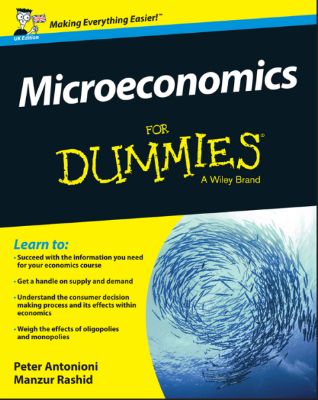
Lýsing:
Your one-stop guide to understanding Microeconomics Microeconomics For Dummies (with content specific to the UK reader) is designed to help you understand the economics of individuals. Using concise explanations and accessible content that tracks directly to an undergraduate course, this book provides a student-focused course supplement with an in-depth examination of each topic. This invaluable companion provides clear information and real-world examples that bring microeconomics to life and introduces you to all the key concepts.
From supply and demand to market competition, you'll understand how the economy works on an individual level, and how it affects you every day. Before long, you'll be conversant in consumers, costs, and competition. Microeconomics is all about the behaviour of individual people and individual firms. It sounds pretty straightforward, but it gets complicated early on. You may not be an economist, but if you're a business student at university, the odds are you need to come to grips with microeconomics.
That's where Microeconomics For Dummies comes in, walking you through the fundamental concepts and giving you the understanding you need to master the material. Understand supply, demand, and equilibrium Examine the consumer decision making process Delve into elasticity and costs of production Learn why competition is healthy and monopolies are not Even the brightest business students can find economics intimidating, but the material is essential to a solid grasp of how the business world works.
Annað
- Höfundar: Peter Antonioni, Manzur Rashid
- Útgáfa:1
- Útgáfudagur: 2015-10-13
- Hægt að prenta út 10 bls.
- Hægt að afrita 2 bls.
- Format:ePub
- ISBN 13: 9781119026716
- Print ISBN: 9781119026693
- ISBN 10: 1119026717
Efnisyfirlit
- Cover
- Introduction
- About This Book
- Foolish Assumptions
- Icons Used in This book
- Beyond the Book
- Where to Go from Here
- Part I: Getting Started with Microeconomics
- Chapter 1: Discovering Why Microeconomics Is a Big Deal
- Peering into the Economics of Smaller Units
- Making Decisions, Decisions and More Decisions!
- Understanding the Problems of Competition and Co-operation
- Investigating Why Markets Can Fail
- Chapter 2: Considering Consumer Choice: Why Economists Find You Fascinating!
- Studying Utility: Why People Choose What They Choose
- Modelling Consumer Behaviour: Economic Agents
- Pursuing Preferences and Investigating Indifferences
- Chapter 3: Looking at Firm Behaviour: What They Are and What They Do
- Delving into Firms and What They Do
- Considering How Economists View Firms: The Black Box
- From Firm to Company: Why People Form Limited Liability Companies
- Chapter 1: Discovering Why Microeconomics Is a Big Deal
- Chapter 4: Living a Life without Limits
- Eating Until You’re Sick! Assuming that More Is Always Better
- Deciding How Low You’ll Go! Marginal Utility
- Chapter 5: Considering the Art of the Possible: The Budget Constraint
- Taking It to the Limit! Introducing the Budget Constraint
- Getting the Biggest Bang for Your Buck
- Putting the Utility Model to Work
- Chapter 6: Achieving the Optimum in Spite of Constraints
- Investigating the Equilibrium: Coping with Price and Income Changes
- Dealing with Price Changes for One Good
- Discerning a Consumer’s Revealed Preference
- Decomposing Income and Substitution Effects
- Chapter 7: Working with Different Costs and Cost Curves
- Understanding Why Accountants and Economists View Costs Differently
- Looking at a Firm’s Cost Structure
- Relating Cost Structure to Profits
- Chapter 8: Squeezing Out Every Last Drop of Profit
- Asking Whether Firms Really Maximise Profits
- Going Large! The Goal of Profit Maximisation
- Slimming Down! Minimising Costs
- Chapter 9: Supplying the Demanded Information on Supply and Demand
- Producing Stuff to Sell: The Supply Curve
- Giving the People What They Want: The Demand Curve
- Identifying Where Supply and Demand Meet
- Chapter 10: Dreaming of the Consumer’s Delight: Perfect Competition
- Viewing the ‘Perfect’ in Perfect Competition
- Putting the Conditions Together for the Perfectly Competitive Marketplace
- Examining Efficiency and Perfect Competition
- Chapter 11: Stepping into the Real World: Oligopoly and Imperfect Competition
- Outlining the Features of an Oligopoly
- Discussing Three Different Approaches to Oligopoly
- Making Your Firm Distinctive from the Competition
- Chapter 12: Appreciating the Fundamental Theorems of Welfare Economics
- Getting the Welfare Back into Welfare Economics
- Understanding Why Partial Equilibrium Isn’t Enough
- Trading Your Way to Efficiency with Two Fundamental Theorems
- Chapter 13: Controlling Markets with a Monopoly
- Entering the World of the Monopoly
- Counting the Costs of Monopolies
- Tackling Monopolies in the Real World
- ‘You Make Me Feel Like a Natural Monopoly’
- Chapter 14: Examining Market Failure: Pollution and Parks
- Coming to Grips with Externality: Too Much of a Bad Thing
- Making the Market Produce What It Won’t: Public Goods
- Chapter 15: Understanding the Dangers of Asymmetric Information
- Seeing the Effects of Asymmetric Information
- Changing Your Behaviour because of Asymmetric Information
- Chapter 16: Playing Games with Economic Theory
- Setting the Game: Mechanism Design
- Locking Horns with the Prisoners’ Dilemma
- Looking at Collective Action: The Stag Hunt
- Annoying People with the Ultimatum Game
- Getting out of the Dilemma by Repeating a Game
- Chapter 17: Keeping Things Stable: The Nash Equilibrium
- Defining the Nash Equilibrium Informally
- Looking for Balance: Where a Nash Equilibrium Must Apply
- Applying the Nash Equilibrium in Economics
- Chapter 18: Knowing How to Win at Auctions
- Spotting Different Kinds of Auction
- Bidding for Beginners
- Suffering from the Winner’s Curse
- Chapter 19: Deciphering the Signals: Threats and Benefits
- Refining the Nash Equilibrium to Deal with Threats
- Responding to Positive Economic Signals
- Chapter 20: Meeting Ten Great Microeconomists
- Alfred Marshall (1842–1924)
- Joseph Alois Schumpeter (1883–1950)
- Gary S Becker (1930–2014)
- Ronald Coase (1910–2013)
- Elinor Ostrom (1933–2012)
- William Vickrey (1914–96)
- George Akerlof (born 1940)
- James Buchanan (1919–2013)
- William Baumol (born 1922)
- Arthur Cecil Pigou (1877–1959)
- Chapter 21: Ten Top Tips to Take Away
- Respecting Choice
- Pricing a Good: Difficult but not Impossible
- Competing on Price or Quality
- Seeking Real Markets’ Unique Features
- Beating the Market in the Long Run is Very Difficult
- Knowing a Tradeoff Always Exists Somewhere
- Arguing about the Next Best Thing
- Using Markets Isn’t Always Costless
- Believing that Competition is Good – Usually
- Getting Co-operation and Organisation in the World
UM RAFBÆKUR Á HEIMKAUP.IS
Bókahillan þín er þitt svæði og þar eru bækurnar þínar geymdar. Þú kemst í bókahilluna þína hvar og hvenær sem er í tölvu eða snjalltæki. Einfalt og þægilegt!Rafbók til eignar
Rafbók til eignar þarf að hlaða niður á þau tæki sem þú vilt nota innan eins árs frá því bókin er keypt.
Þú kemst í bækurnar hvar sem er
Þú getur nálgast allar raf(skóla)bækurnar þínar á einu augabragði, hvar og hvenær sem er í bókahillunni þinni. Engin taska, enginn kyndill og ekkert vesen (hvað þá yfirvigt).
Auðvelt að fletta og leita
Þú getur flakkað milli síðna og kafla eins og þér hentar best og farið beint í ákveðna kafla úr efnisyfirlitinu. Í leitinni finnur þú orð, kafla eða síður í einum smelli.
Glósur og yfirstrikanir
Þú getur auðkennt textabrot með mismunandi litum og skrifað glósur að vild í rafbókina. Þú getur jafnvel séð glósur og yfirstrikanir hjá bekkjarsystkinum og kennara ef þeir leyfa það. Allt á einum stað.
Hvað viltu sjá? / Þú ræður hvernig síðan lítur út
Þú lagar síðuna að þínum þörfum. Stækkaðu eða minnkaðu myndir og texta með multi-level zoom til að sjá síðuna eins og þér hentar best í þínu námi.
Fleiri góðir kostir
- Þú getur prentað síður úr bókinni (innan þeirra marka sem útgefandinn setur)
- Möguleiki á tengingu við annað stafrænt og gagnvirkt efni, svo sem myndbönd eða spurningar úr efninu
- Auðvelt að afrita og líma efni/texta fyrir t.d. heimaverkefni eða ritgerðir
- Styður tækni sem hjálpar nemendum með sjón- eða heyrnarskerðingu
- Gerð : 208
- Höfundur : 11026
- Útgáfuár : 2015
- Leyfi : 380


